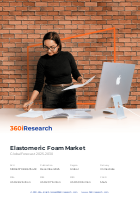
Elastomeric Foam Market by Elastomer Type (Chloroprene Rubber, Ethylene Propylene Diene Monomer (EPDM), Ethylene-vinyl Acetate), Form (Sheets & Rolls, Tubes), Cell Structure, Application, End-Use Industry, Sales Channel - Global Forecast 2025-2030
SKU
MRR-E3708867643C
Region
Global
Publication Date
December 2025
Delivery
Immediate
2024
USD 2.82 billion
2025
USD 2.97 billion
2030
USD 3.90 billion
CAGR
5.54%

Download a Free PDF
Get a sneak peek into the valuable insights and in-depth analysis featured in our comprehensive elastomeric foam market report. Download now to stay ahead in the industry! Need more tailored information? Ketan is here to help you find exactly what you need.



